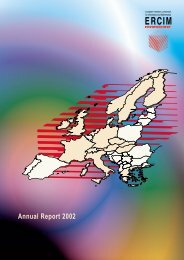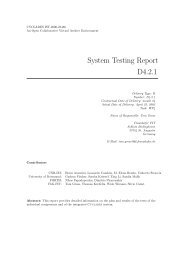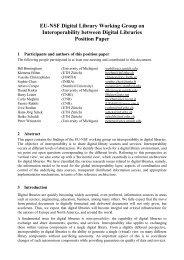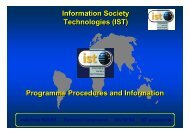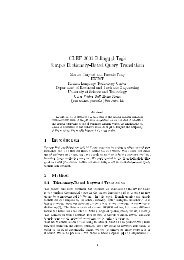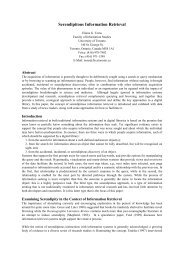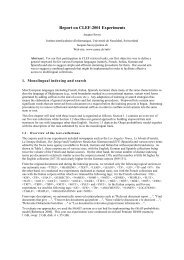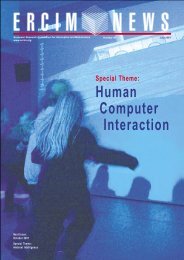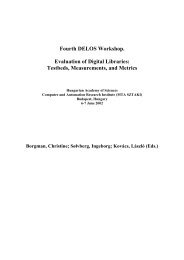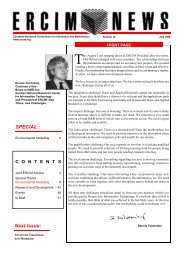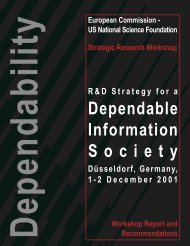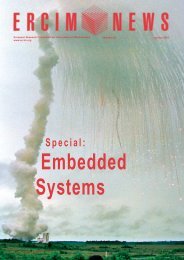Towards a Platform for Widespread Embedded Intelligence - ERCIM
Towards a Platform for Widespread Embedded Intelligence - ERCIM
Towards a Platform for Widespread Embedded Intelligence - ERCIM
You also want an ePaper? Increase the reach of your titles
YUMPU automatically turns print PDFs into web optimized ePapers that Google loves.
R&D AND TECHNOLOGY TRANSFER<br />
Mobile Hybrid Wireless Networks<br />
HyMN: A Self-Organizing System<br />
<strong>for</strong> Interest-based Data Distribution<br />
in Mobile Hybrid Wireless Networks<br />
by Steffen Rothkugel, Matthias R. Brust, Adrian Andronache<br />
The concept of self-organisation already exists in the realm of ad-hoc networks.<br />
The inherent limitations of pure ad-hoc networks can be overcome by introducing<br />
uplinks to the Internet backbone. Extending the principles of self-organisation<br />
by transparently including those additional network links is the focus of the<br />
HyWercs project. HyMN, in turn, is a system aimed at fostering user experience<br />
by employing these concepts in the domain of multimedia content distribution.<br />
Ad-hoc networks emphasise flexibility<br />
and survivability of the whole system.<br />
However, centralised approaches, <strong>for</strong><br />
example <strong>for</strong> group management and<br />
in<strong>for</strong>mation provisioning, do not work<br />
well in such settings. Moreover, due to<br />
frequent topology changes, connectivity<br />
of devices cannot be generally<br />
guaranteed. In particular, this makes it<br />
hard to disseminate in<strong>for</strong>mation in a<br />
reliable way. We overcome these limitations<br />
inherent to pure ad-hoc networks<br />
by (a) establishing local groups<br />
of communicating devices in a sel<strong>for</strong>ganising<br />
manner and (b) introducing<br />
dedicated uplinks to a backbone infrastructure.<br />
Such uplinks are used <strong>for</strong><br />
accessing resources available on the<br />
Internet. Additionally, they are<br />
employed to directly interconnect distant<br />
devices, either within a single partition<br />
and particularly also across different<br />
partitions. In practice, uplinks are<br />
realised <strong>for</strong> instance using cellular networks,<br />
satellites, or via Wi-Fi hotspots.<br />
Consequently, ad-hoc networks with<br />
devices that provide uplinks are called<br />
hybrid wireless networks throughout<br />
this paper.<br />
One main goal of the HyWercs project is<br />
to develop a middleware that enables<br />
mobile devices to organise themselves in<br />
order to optimise the data access and<br />
provisioning process. The devices running<br />
the middleware keep track of the<br />
user's interests, which can be single data<br />
items or topics that comprise several data<br />
items. Devices sharing common interests<br />
will join interest groups. Whenever there<br />
is the need to retrieve in<strong>for</strong>mation from a<br />
backbone network - like the Internet - or<br />
52 <strong>ERCIM</strong> News No. 67, October 2006<br />
to establish a communication link to a<br />
device in another network partition,<br />
uplinks are employed. The mobile<br />
devices elect a particular member of the<br />
interest group, a so-called injection<br />
point, which maintains the uplinks.<br />
As one proof of concept, the HyMN<br />
system (Hybrid Multimedia Network)<br />
has been implemented prototypically on<br />
top of the JANE1 simulation environment.<br />
JANE is designed to support appli-<br />
The HyMN System in simulation mode.<br />
cation and protocol design in the realm<br />
of ad-hoc networks. One distinct feature<br />
of JANE is that applications can be executed<br />
on top of simulated devices (see<br />
figure) as well as in so-called plat<strong>for</strong>m<br />
mode on real hardware.<br />
HyMN is designed <strong>for</strong> users interested in<br />
live multimedia news, <strong>for</strong> example from<br />
certain sports events. Mobile devices of<br />
football fans, <strong>for</strong> instance, create an<br />
interest group in a local ad-hoc network<br />
partition. Multiples of such groups coexist,<br />
such as football fans in pubs, those<br />
watching another match, traveling fans<br />
and more. In each of these cases, a considerable<br />
number of people have a<br />
shared interest and might join <strong>for</strong>ces in a<br />
local setting.



